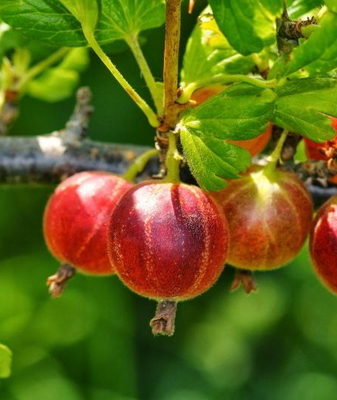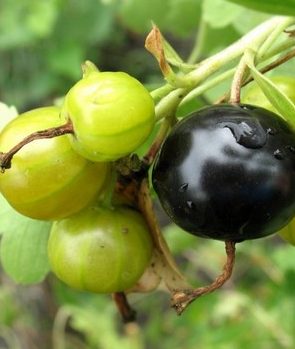Gooseberry caterpillars ate leaves, how to fight
Content:
Caterpillars on gooseberries: briefly about the beginning of activity
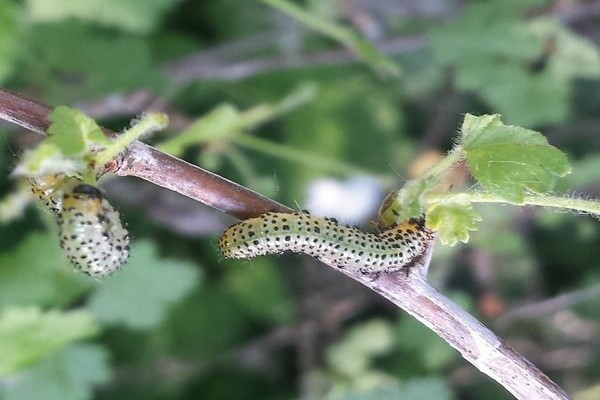
Caterpillars on gooseberries: photos
In the spring, not only trees, grasses and shrubs bloom and grow, but also harmful insects wake up from sleep, which can spoil your plants or even destroy them. Insects love to eat gooseberry leaves, most often the larvae of caterpillars do this. It is very important to carry out prevention against various pests.
Who eats gooseberries
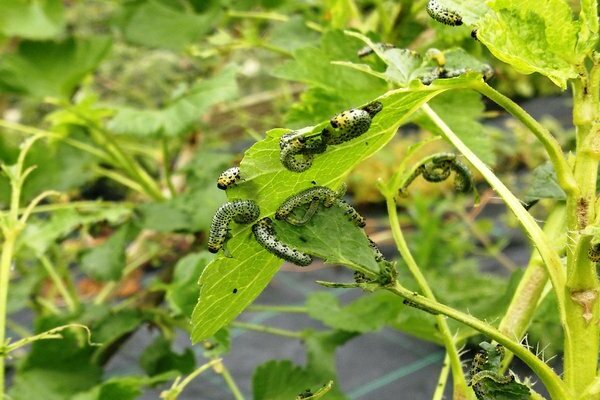
Caterpillars on gooseberries: photos
Caterpillars most often spoil your plantings, they like to devour the leaves of plants. There are more than one species of caterpillar larvae. Due to the existence of different species, there are also different ways to deal with them.
- Gooseberry moth - a green larva that spoils the harvest, about a couple of centimeters long - a gooseberry moth.
- Gooseberry sawfly... Another foliage eater is the gooseberry sawfly, usually with a blue and green tint, and has dark spots.
- Gooseberry aphid - small green larvae, the larvae slow down the growth of plants, the leaves begin to change shape and curl.
- Spider mite. A very small insect, both in an adult and in a small form - a spider mite, can only be seen with special devices and cause the leaves to die off.
Caterpillars on gooseberries: identification of larvae and their species on plant leaves
To choose the right way to fight insects, you need to teach how to identify them correctly. There are important signs of the "appearance" of insect pests, it is important to know such features and be able to distinguish pests from each other. This is very important information for gardeners.
Caterpillars on gooseberry: sawflies on gooseberry shoots
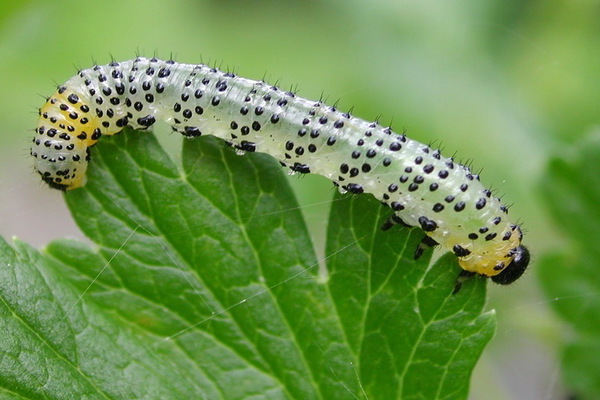
Gooseberry caterpillar: photo
Usually the most difficult insect to hatch is the sawfly caterpillar. Gardeners often meet with the complete destruction of leaves by this species. Also, this type of pest often likes to destroy various types of currants.
The yellow and pale-footed caterpillars are the most common sawfly caterpillars.
Both varieties eat leaves often at zero, even the pitiful ones can often be eaten. They look like regular caterpillars. The color ranges from green to slightly blue. They have twenty legs. The caterpillars have dark spots over the entire surface area.
In winter, insects and larvae survive near the main stem of plants in the ground. Caterpillars winter in thick cocoons fourteen centimeters underground. With the onset of the first warming, the larvae acquire cocoons, during the beginning of the flowering periods of the plant for attack, the cocoons turn into adult insects.
When fresh leaves begin to form, the female begins laying eggs on their underside. After a fairly short time, pests hatch and begin to grow very rapidly. First, small holes appear on the leaves, eventually absorbing the entire leaf. On average, caterpillars live twenty-five to thirty days, from the cocoon stage to the adult stage.Then the insect descends to the ground, enters the cocoon stage, and everything is repeated from the beginning.
Due to the fact that the larvae are microscopic in size, it is impossible to see them without special devices. Of course, when they start to grow, minimal holes appear on the leaves, but they are usually overlooked.
Attention! If you understand that the number of individuals of this species is very large, then it may not be possible to save the plant, and in the second week your plant, unfortunately, will die under their onslaught.
There are several serious negative consequences of an attack by these pests.
- The harvest is getting smaller and its quantity is decreasing. The berries fall off quickly enough.
- Shoots are greatly slowed down in growth. In winter, the bushes become less resistant.
Gooseberry caterpillars: moths are green caterpillars

When you notice green caterpillars on a gooseberry, there is almost a 100% chance that they are moths. Moths are very harmful to gooseberries.
Average size within one and a half centimeters. There are black stripes, the main color is green, quite saturated. The head is black.
Pupae survive the winter in the upper soil layers. Pupae open and butterflies appear during the flowering period. Butterflies lay their eggs at the end of flowering in florets. There is an average indicator - two hundred eggs, this is how many eggs one female lays on a plant. In a little over a week, small individuals emerge from the eggs. Little caterpillars literally eat everything they can. Caterpillars live on leaves for about a month, as a rule, the state of the plant deteriorates greatly during this short period. Most often, nutrition occurs due to the fruits themselves and the seeds that they contain. Consuming each berry, the caterpillars weave a web around it.
Pupation or transformation into a pupa occurs after a month of the life of a caterpillar on a plant, often pupae are formed during the collection of berries.
There are several characteristic signs of a moth caterpillar attack.
- The berries are "perforated" and a barely noticeable web is stretched between the berries.
- When a cobweb coma is found, about six berries can be seen, there are both undamaged fruits and rotten ones, and impossible to eat.
- When such lumps are opened, the caterpillars themselves can be seen.
Gooseberry caterpillars: glass
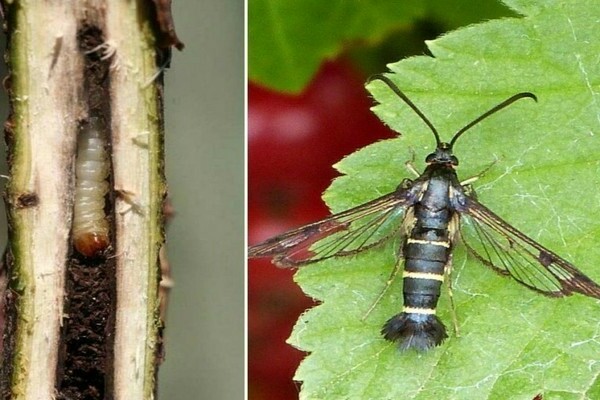
Most often, this species appears on currants, but it is very dangerous for gooseberries.
At the very beginning of the development and formation of these individuals, it is almost impossible to see them. Because of this, the vast majority of gardeners begin to breed insects when the plants can no longer be saved. Glass currant can eat all plants if they are not found in time.
On the branches of the bush, adult females lay about six dozen eggs.
The larvae are white. The heads are black. Everyone eats very quickly. Harmful larvae hatch from eggs almost two weeks after they are laid. At this time, individuals are very vulnerable. Caterpillars are easy to destroy while they feed on leaves, then they go directly into the bushes and simply gnaw right through them. It turns out that the bushes are deprived of vitality from the inside. Insects also spend winter inside the plants and, with the onset of warmth, leave their shelters to lay the next batch of eggs.
Signs of an attack of gooseberries with glass
- If these caterpillars live on a branch, then, as a rule, there are fewer shoots on it than on a healthy one.
- In very hot weather, the leaves wither and crumble rapidly.
- The plant dies when the glassware has been living in it for the second year already.
- If you cut off the attacked shoot, you can see a hole in its middle with the consequences remaining from insects.
Most often it happens that the owner of the garden or the person who is watching him is to blame for the attacks of the caterpillars.
The caterpillars on the gooseberry ate the leaves: how to fight?
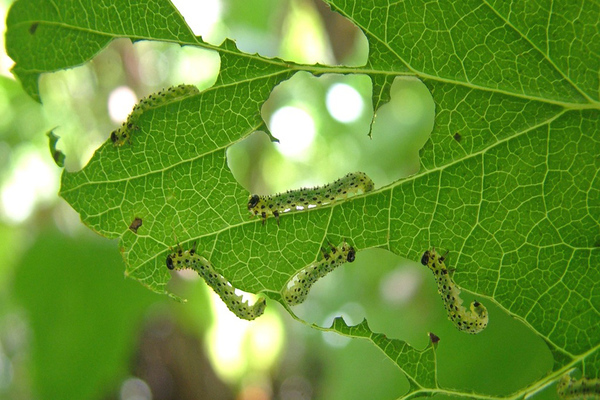
There are different methods for controlling caterpillars on the leaves, fruits and shoots of gooseberries.It is possible to use, as well as several methods at the same time, and only one. The most important thing is to recognize pests at the beginning of their formation and begin to destroy harmful insects immediately in order to keep the plant alive.
How to treat gooseberries from caterpillars? Folk remedies means
- Next to the gooseberry, you can plant an odorous plant - a red elderberry, it is able to scare away caterpillars.
- It is possible to pollinate plants with an elderberry solution: two hundred grams of ground flowers and shoots are bred in ten liters of hot water. The mixture should be infused for about two hours and can be used. The solution can be sprayed on the plant during and after flowering to destroy the caterpillars.
- You can fumigate it with the help of tobacco dust. On the leeward side, collect a “mountain” from dry garbage, and on the top place a couple of kilograms of tobacco dust. Fumigation should continue for about half an hour.
- You can sprinkle the ground near the bushes with a mixture: one tablespoon of ground mustard, a faceted glass of tobacco dust and three hundred grams of wood ash.
- You can spray the plants with a solution of one hundred grams of young spruce cones, filled with heated liquid. The solution is infused for five hours and the plants can be sprayed. Processing will be required once a week during the entire flowering period.
- All home remedies work well when repeated regularly, loosening soil near plants, performing sanitary pruning, and picking up spoiled fruit.
How to treat gooseberries from caterpillars? Chemicals
Not only homemade recipes, but also industrial chemicals will help in the fight against attacking caterpillars. The most commonly used and effective drugs are considered to be several.
Chlorophos
The product produced in various forms, powders / pastes - chlorophos. It is possible to purchase the drug in different concentrations. Well destroys attacks of sawflies and moths on gooseberry shoots
Entobacterin - 3
The drug against sawflies is entobacterin 3. The air temperature during its application should be above twenty degrees. The remedy is recommended by many and is very popular due to the fact that it does not affect the life of other plants and humans in any way. To make the action even more beneficial, it can be mixed with chlorophos.
Sevin
The drug that overcomes larvae and eggs is sevin. It is used not only against the larvae, but also against the glassworm and fireworm. The drug is sprayed over the shoots of the plant, but strictly before the beginning of the flowering periods.
Pyrethrum
Perhaps the most harmful agent is feverfew, it is very toxic. Use as powder and dilute with water. Gooseberry shoots are pollinated.
Important! All of the above actions must be carried out in dry weather and always with the presence of a protective suit on the person who will be processing.
Mechanical ways to control pests
Perhaps, for good reason, these are the simplest, cost-free and open to all people methods of pest control. Mechanical processing will need to be carried out regularly, tracking according to the schedule of action. This is the discharge of larvae from leaves and branches, the collection of adults from the shoots of a bush.
You can spread glue belts on the surface of the branches, they are poured with a special sticky solution and everything sticks to it. The solution can be made from burdock oil and boiling tar, you need to mix the components in a ratio of one to two.
Prevention from eaters
As you can see, it is very difficult and time-consuming to fight insects, to avoid this it will be enough to follow a number of simple rules. Prevention should be carried out four times a year: in autumn, spring, before and immediately after the gooseberry flowering period.
There are four main types of preventive measures
- Ash, grated chalk and copper sulfate are a solution that should be used to process the leaves and the ground around the gooseberry with the onset of the first spring heat.
- The larvae hibernate in the ground, so that their lime needs to be watered with boiling water near the roots, it can be slightly less than a hundred degrees.
- When the leaves begin to fall in the fall, they should be collected and burned.
- There are no harmful chemicals with which it will be necessary to treat the foliage of the bushes in March-April.
Conclusion
In the end, I would like to say that gooseberries are really susceptible to attacks from various caterpillars and sometimes it is rather difficult to fight them. The fight can take your time, money and nerves, but soon you will defeat the insects. Now you know how to eliminate this infection and save your beautiful plants. If you've been attacked this year, take precautions next year and enjoy a wonderful harvest.


